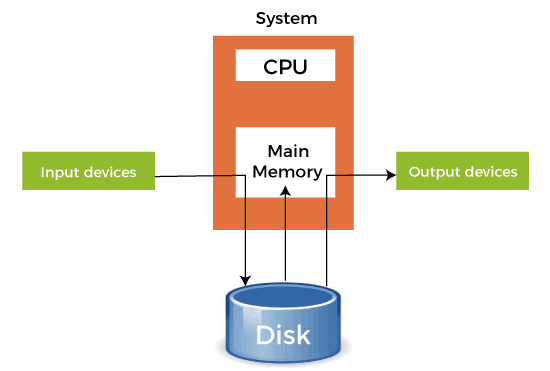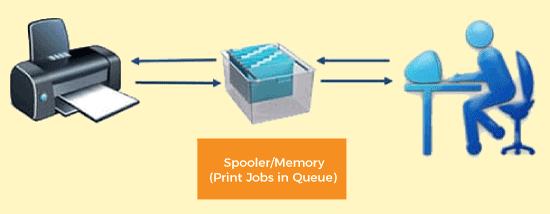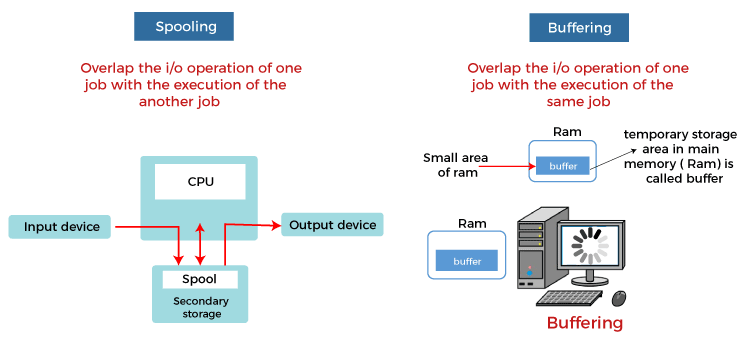What is Spooling?
1. Spooling involves creating
a buffer called SPOOL, which is used to hold off jobs and data till the device
in which the SPOOL is created is ready to make use and execute that job or
operate on the data.
What is Spooling?
· Spooling is a process in which data is temporarily held to be used and executed by a device, program, or system. Data is sent to and stored in memory or other volatile storage until the program or computer requests it for execution.
·
SPOOL is an acronym for simultaneous peripheral operations
online. Generally, the spool is maintained on the computer's
physical memory, buffers, or the I/O device-specific interrupts. The spool is
processed in ascending order, working based on a FIFO (first-in, first-out)
algorithm.
Spooling refers to
putting data of various I/O jobs in a buffer. This buffer is a special area in
memory or hard disk which is accessible to I/O devices. An operating system
does the following activities related to the distributed environment:
o Handles
I/O device data spooling as devices have different data access rates.
o Maintains
the spooling buffer, which provides a waiting station where data can rest while
the slower device catches up.
o Maintains
parallel computation because of the spooling process as a computer can perform
I/O in parallel order. It becomes possible to have the computer read data from
a tape, write data to disk, and write out to a tape printer while it is doing
its computing task.
How
Spooling Works in Operating System
In an operating system, spooling works in the following steps,
such as:
2. When a faster device sends
data to a slower device to perform some operation, it uses any secondary memory
attached as a SPOOL buffer. This data is kept in the SPOOL until the slower
device is ready to operate on this data. When the slower device is ready, then
the data in the SPOOL is loaded onto the main memory for the required
operations.
3. Spooling considers the
entire secondary memory as a huge buffer that can store many jobs and data for
many operations. The advantage of Spooling is that it can create a queue of
jobs that execute in FIFO order to execute the jobs one by one.
4. A device can connect to
many input devices, which may require some operation on their data. So, all of
these input devices may put their data onto the secondary memory (SPOOL), which
can then be executed one by one by the device. This will make sure that the CPU
is not idle at any time. So, we can say that Spooling is a combination of
buffering and queuing.
5. After the CPU generates
some output, this output is first saved in the main memory. This output is
transferred to the secondary memory from the main memory, and from there, the
output is sent to the respective output devices.
Example of Spooling
The biggest example of Spooling is printing. The documents which are to be printed are stored in the SPOOL and then added to the queue for printing. During this time, many processes can perform their operations and use the CPU without waiting while the printer executes the printing process on the documents one-by-one.
Many features can also be added to the Spooling printing process, like setting priorities or notification when the printing process has been completed or selecting the different types of paper to print on according to the user's choice.
Advantages of Spooling
Here are the following advantages of spooling in an operating system, such as:
- The
number of I/O devices or operations does not matter. Many I/O devices can
work together simultaneously without any interference or disruption to
each other.
- In
spooling, there is no interaction between the I/O devices and the CPU.
That means there is no need for the CPU to wait for the I/O operations to
take place. Such operations take a long time to finish executing, so the
CPU will not wait for them to finish.
- CPU in
the idle state is not considered very efficient. Most protocols are
created to utilize the CPU efficiently in the minimum amount of time. In
spooling, the CPU is kept busy most of the time and only goes to the idle
state when the queue is exhausted. So, all the tasks are added to the
queue, and the CPU will finish all those tasks and then go into the idle
state.
- It
allows applications to run at the speed of the CPU while operating the I/O
devices at their respective full speeds.
Disadvantages of Spooling
In an operating system, spooling has the following disadvantages, such as:
- Spooling
requires a large amount of storage depending on the number of requests made
by the input and the number of input devices connected.
- Because
the SPOOL is created in the secondary storage, having many input devices
working simultaneously may take up a lot of space on the secondary storage
and thus increase disk traffic. This results in the disk getting slower
and slower as the traffic increases more and more.
- Spooling
is used for copying and executing data from a slower device to a faster
device. The slower device creates a SPOOL to store the data to be operated
upon in a queue, and the CPU works on it. This process in itself makes
Spooling futile to use in real-time environments where we need real-time
results from the CPU. This is because the input device is slower and thus
produces its data at a slower pace while the CPU can operate faster, so it
moves on to the next process in the queue. This is why the final result or
output is produced at a later time instead of in real-time.
Difference between Spooling and
Buffering
Spooling and buffering are the two ways by which I/O subsystems improve the performance and efficiency of the computer by using a storage space in the main memory or on the disk.
The basic difference between Spooling and Buffering is that Spooling overlaps the I/O of one job with the execution of another job. In comparison, the buffering overlaps the I/O of one job with the execution of the same job. Below are some more differences between Spooling and Buffering, such as:
|
Terms |
Spooling |
Buffering |
|
Definition |
Spooling,
an acronym of Simultaneous Peripheral Operation Online (SPOOL), puts data
into a temporary working area to be accessed and processed by another program
or resource. |
Buffering is an act of storing data temporarily in the buffer.
It helps in matching the speed of the data stream between the sender and receiver. |
|
Resource requirement |
Spooling
requires less resource management as different resources manage the process
for specific jobs. |
Buffering requires more resource management as the same
resource manages the process of the same divided job. |
|
Internal implementation |
Spooling
overlaps the input and output of one job with the computation of another job. |
Buffering overlaps the input and output of one job with the
computation of the same job. |
|
Efficient |
Spooling
is more efficient than buffering. |
Buffering is less efficient than spooling. |
|
Processor |
Spooling
can also process data at remote sites. The spooler only has to notify when a
process gets completed at the remote site to spool the next process to the
remote side device. |
Buffering does not support remote processing. |
|
Size on memory |
It
considers the disk as a huge spool or buffer. |
Buffer is a limited area in the main memory. |
.png)



